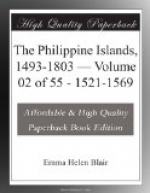their cargoes; for it is one of the foremost ports
in the discovery of the Indies—large, safe,
very healthful, and with a supply of good water.
It abounds in fish; and at a distance of five or six
leagues there is an abundance of wood for the buttock-timbers
of the vessels, and, some distance farther, of wood
for decks and sheathing, and pines for masts and yards.”
Further, the district about this port is reasonably
well populated. Urdaneta says that if material
for making the artillery be sent from Spain, and good
workmen, the artillery can be made in New Spain; as
well as anchors. “In this land there is
copper in abundance, from which artillery can be made,”
which only needs to be refined. The Augustinian
makes some interesting observations regarding social
and economic conditions in Mexico, and suggests that
it would be very advantageous to compel many youths
who are growing up in vagabondage to learn trades,
“especially the
mestizos, mulattoes, and
free negroes.” Weapons, ammunition, and
defensive armor must be sent from Spain for this expedition.
Urdaneta requests that hemp-seed be sent, in order
that ropes may be made in New Spain. He tells
of a plant
pita [agave], growing in this country
which can be used as a substitute for hemp, and many
plants of it must be planted near the ports. The
pitch, tar, and resin, the instruments and charts for
navigation,
etc., must be sent hither from Spain.
They need good seamen and workmen. The king is
requested to allow them to make use of any workmen
in the other provinces of “these parts of the
Indies,” paying them their just wages; likewise
to take what things they need, paying the just price.
It is advised that the necessary trees for shipbuilding
be planted near the ports, and that ranches be established
near by to furnish food.
The second section of this document treats of the
navigation to the Western Islands: and Urdaneta
maps out various routes which should be followed,
according to the time of the year when the fleet shall
depart on its voyage of discovery. These routes
all have to do primarily with New Guinea as the objective
point of the expedition, the Philippines being considered
as only secondary thereto. Speaking of the Ladrones
and their inhabitants, Urdaneta says: “The
islands of the Ladrones are many, and thirteen [42]
of them are said to be inhabited. The inhabitants
are naked and poor. They eat rice, have many
cocoa palms, and use salt. They fish with hooks
made from tortoise-shell, being destitute of articles
made from iron. They place a counterweight in
one end of their canoes, and rig on them lateen-like
sails made of palm-mats. It is quite important
to explore this island thoroughly, or any of the others,
in order to discover and ascertain accurately the
navigation that has been made up to that point, and
their distance from Maluco and the Filipinas Islands
... Those islands are somewhat less than three
hundred and seventy leagues from Botaba [one of the




